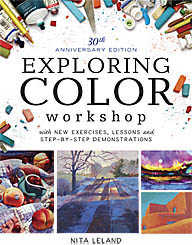The transformative power of art
Imagine being a parent of a mentally disabled son, one who can speak and move but is somewhat unable to relate to the world about him or to achieve skills normal to children his age. As a devoted parent, you would take every opportunity to find activities to interest your child, hoping to kindle a spark that might brighten his life and alleviate the pain you feel for him. This was the life of Mary Pearce, whose son Bryan was afflicted with phenylketonuria (PKU), a genetic disorder that causes chemical imbalances that may result in brain damage. Babies today are tested for PKU at birth and given special diets if they test positive for the disease, but when Bryan was born in 1929, no such tests existed. When he was a boy his mother discovered that he seemed to enjoy painting objects in watercolor and had rather a gift for it. An artist friend agreed to tutor him. Eventually, in 1953 he was accepted into Leonard Fuller's St. Ives School of Painting in Cornwall, England. Bryan blossomed as a naive painter of the landscape and seascape around St. Ives and rendered still life subjects, as well. > In time his work attracted notice and he was invited to exhibit in galleries. At first he didn't understand that these opportunities meant he could become self-supporting. Eventually he became proud that his art gave him a degree of independence. Instead of languishing in an institution, Bryan Pearce has lived a fulfilling life because of art. His work is prized by collectors all over the world. Bryan's inspiring story is told movingly in The Miracle of Bryan Pearce by C. J. Stevens.
In time his work attracted notice and he was invited to exhibit in galleries. At first he didn't understand that these opportunities meant he could become self-supporting. Eventually he became proud that his art gave him a degree of independence. Instead of languishing in an institution, Bryan Pearce has lived a fulfilling life because of art. His work is prized by collectors all over the world. Bryan's inspiring story is told movingly in The Miracle of Bryan Pearce by C. J. Stevens.
 In time his work attracted notice and he was invited to exhibit in galleries. At first he didn't understand that these opportunities meant he could become self-supporting. Eventually he became proud that his art gave him a degree of independence. Instead of languishing in an institution, Bryan Pearce has lived a fulfilling life because of art. His work is prized by collectors all over the world. Bryan's inspiring story is told movingly in The Miracle of Bryan Pearce by C. J. Stevens.
In time his work attracted notice and he was invited to exhibit in galleries. At first he didn't understand that these opportunities meant he could become self-supporting. Eventually he became proud that his art gave him a degree of independence. Instead of languishing in an institution, Bryan Pearce has lived a fulfilling life because of art. His work is prized by collectors all over the world. Bryan's inspiring story is told movingly in The Miracle of Bryan Pearce by C. J. Stevens.Labels: art therapy, artist, tutorials





0 Comments:
Post a Comment
<< Home